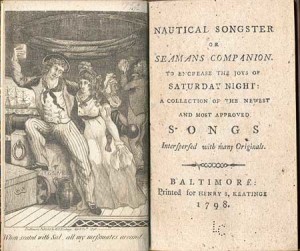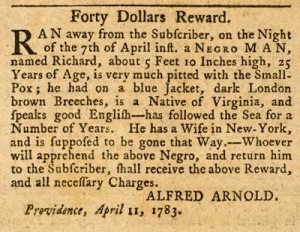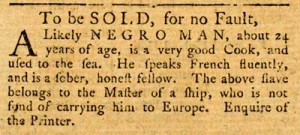Developing a database of mariners in the Black Atlantic
Many people assume that mariners in the age of sail were rambunctious tars. Weathered seamen are often depicted quickly spending their hard-earned pay ashore drinking and whoring. Contemporary illustrations such as the frontispiece for Nautical Songster or Seaman’s Companion helped cement this image. Movies continue to reinforce this perception of footloose sailors. Nautical adventurers, be they Russell Crowe as Captain Jack Aubrey in Master and Commander or Johnny Depp as the swashbuckling Jack Sparrow in Pirates of the Caribbean, appeal to many individuals who, like the cartoon character Dilbert, find little excitement in their daily routines working in cubicles. While I admit to having watched these movies, for seven years much of my time has been spent in archival reading rooms on both sides of the Atlantic in a venture far more prosaic. Unlike Jack Aubrey, I did not chase a forty-four-gun French warship around the Cape of Horn. Instead, my task involved a more elusive goal: to find evidence of the lives of colored—that is African American, Native American, or mixed-race—mariners, individuals who rarely make it onto the big screen today and who were often depicted as servants in eighteenth-century illustrations.
Last year I completed a dissertation concerning how fugitive slaves used the maritime industries in eighteenth-century Philadelphia, New York, and Newport to achieve freedom. My research resulted in the development of a database of more than 9,100 colored mariners—the Colored Mariner Database (CMD).In an era when researchers increasingly rely upon Web-based sources, one may ask why I would choose to travel to more than thirty archives on both sides of the Atlantic and spend seven years creating the CMD to identify and trace the lives of eighteenth-century colored mariners. The answer to the question lies in the very nature of the Black Atlantic.
Moving frequently, leading short lives, and owning little property, mariners rarely left traces of their lives. Colored mariners, particularly those who sought to escape assorted forms of bondage via the sea, left only scattered remnants of their lives in the historical record. These men often carried forged passes, changed clothes, and in other creative ways concealed their identities. To find freedom, many of them traversed national, ethnic, and religious borders. In short, colored mariners’ success in obtaining freedom or remaining free depended on being elusive. So how to identify colored sailors and detail their lives? The answer to this question was not a simple one. Few blacks, mulattos, mezitos, or Native Americans in the eighteenth century were literate. North American vessels of the era were not required to maintain crew lists. And few slave runaways were so foolhardy as to leave evidence indicating their intended destination. The fluid, transitory nature of life in the Black Atlantic made my intended task seem a bit daunting.
Two groups of people deeply concerned with slaves who sought freedom at sea, slave masters and ship captains, provided me with an initial window into colored mariners’ lives. As many historians have noted, the language of fugitive slave advertisements is richly descriptive. The thousands of fugitive-slave and slave-sale advertisements published in Philadelphia, New York City, and Rhode Island newspapers contained considerable evidence of colored men working or seeking to work at sea. Scipio Congo and hundreds of other runaway slaves were described by their masters as having been “used to the sea,” “bred a sailor,” or having threatened to go to sea. In these advertisements slave masters repeatedly admonished ship captains not to “harbour or conceal” runaways. Whites’ laments over slaves who fled via the sea were widespread. Just as Samuel Johnson discovered his Negro servant wished to go to sea, slave masters from diverse social strata in North America—including Newport farmers, New York merchants, South Carolinian rice planters, Philadelphia artisans, and Maryland’s governor—suffered the indignity of bondsmen escaping to the sea. Slave owners offered rewards for the capture of maritime fugitives and hoped that “no gentleman” would stoop so low as to hire runaway slaves. Yet masters such as New York’s Donald McClean repeatedly found their slaves hired by ship captains. And at the same time that some slave masters bemoaned their slaves’ flight via the sea, others were quite willing to send their bondsmen on privateer ships hoping to enrich themselves from prize monies their slave mariners earned them.
If fugitive-slave and slave-sale advertisements provide a valuable starting point, they offer only a small window into colored mariners’ lives. They do not tell us which maritime fugitives successfully escaped to the sea, how many colored mariners sailed the Atlantic, or where maritime fugitives ultimately ended up. They do not tell us about the nature of their lives at sea or how most colored mariners’ lives may have compared to that of the iconic eighteenth-century colored mariner, Oladauh Equiano. Like Equiano, did they experience slavery in the West Indies, North America, and England? How many served in the Royal Navy and faced enemy guns, as did the young Oladauh? Was Equiano’s extended maritime career—during which he traveled across the globe in slave, naval, and merchant ships—unusual? And were significant numbers of these men able to obtain freedom, whether through purchasing themselves, as had Equiano, or running away? To answer those questions, I combined my review of advertisements with painstaking archival research.
Advertisements indicated colored mariners sought berths on ships sailing to ports throughout the Atlantic and that a number of maritime fugitives and slave mariners came from non-English colonies. Given the diverse backgrounds of colored mariners, it made no sense to limit my research to archives in the three study ports. At the same time, I did not wish to engage in an overly ambitious project, which might have tested the patience of my advisor and my wife. To make the project manageable, I headed to England to take full advantage of the Royal Navy’s mania for records.
As maritime historians have demonstrated, Royal Navy musters, pay books, and pension records are a treasure trove of information. Providing names, ages, positions, and places of birth for every seaman who came aboard a naval vessel, these records are a social historian’s dream. Unfortunately for my purposes the data was incomplete. My first task was to determine the race of each mariner on a warship. With the race of seamen not being noted in musters and payrolls such identification was difficult. The Admiralty’s 1764 requirement that seamen’s places of birth be entered into musters greatly assisted in identifying and tracking colored mariners. But for seamen who served prior to 1764, the lack of places of birth meant numerous colored mariners often could not be identified as surnames alone rarely revealed a sailor’s race. For example, I would have never included John Henry on HMS Brune in the CMD except that when he died the Burne‘s log referred to him as “one of our Negroes.” Thus, my identification of a mariner as colored was often predicated on the tar having a classical name, like Scipio; an African name, like Quash; or a place name, like Bristol.
Using ship pay records, I set out to answer two questions about colored mariners. First, did fugitive slaves find haven on naval ships? And second, could I trace the lives of some of the colored mariners I had identified from other sources? For the first question, I conducted a random sampling of Royal Navy ships on the North America station during my study period, 1713 to 1783. For the second I matched ship logs with fugitive advertisements to identify ships that maritime fugitives may have fled onto. Making good use of the National Archives’ friendly staff and the archives’ bulk order procedures, I set myself up in the Map Room next to a trolley stacked high with ship records. With at least one archive staff member referring to me as the “muster guy,” I spent long hours scanning musters and payrolls. On many days, I headed back to the Kew tube station with little more than blurry eyes and dirty hands: an average day’s work might yield only three or four additions to the CMD.What kept me going back after a day of limited success was the knowledge that naval records could yield details to lives for which I previously only had a line or two of information. In many ways, my days at the National Archives resembled the proverbial search for the needle in a haystack. But that work ultimately resulted in the productive melding of social and Atlantic history. Two of my discoveries illustrate this well.
A compilation of naval records had provided me with the story of four slave sailors on a ship from St. Thomas who found themselves in Portsmouth during the American Revolution due to a broken ship rudder. The seamen convinced naval officials of their rights under the English law not to be forced to continue to work as slaves on the ship. The case was particularly interesting because it involved slave sailors from throughout the Atlantic: North America, the British West Indies, Calabar, and St. Thomas. But what happened to these men once they left the ship in Portsmouth was unknown. A review of court, tax, land, and church records in the Portsmouth City Records Office provided no information on the men. However, a search of records for warships in Portsmouth at the time the men landed there yielded a significant discovery: one of the men had been subsequently impressed onto a naval ship! While we might not know the details of these men’s lives after they gained their freedom, the fate of this unfortunate sailor reminds us that in the eighteenth-century Anglo-American maritime world, freedom from enslavement did not always mean freedom from coerced labor.
The second story was even more descriptive of the limits of freedom for colored mariners and sadder for being so. When reviewing the muster for HMS Garlands, I noticed an entry indicating that twenty-eight-year-old able-bodied seaman John Incobs had been discharged on October 19, 1764, for “being a slave.” Incobs had entered the Garlands at Sheerness in May 1763 with the ship sailing to Canada. Apparently he was unaware that the warship would subsequently sail to New York where it arrived on October 3, 1764. What the muster did not indicate was that Incobs had been either a New York slave sail maker or mariner who years earlier had escaped and made his way to England. Unfortunately for Incobs, the two weeks HMS Garlands had been in New York was sufficient time for his former owner to reclaim him.
With such discoveries, I slowly, incrementally began to develop a picture of a maritime world in which colored seamen played a not insignificant role. My random review of musters demonstrated that colored mariners were on almost every naval vessel in North America. However, contrary to some historians’ view that “roughly a quarter of the Royal Navy was black,” my sampling showed that the number of identifiable colored mariners never exceeded 6 percent of the Royal Navy’s North American crews. Naval musters also reflected that opportunities for advancement were available to colored tars, as some advanced from ordinary to able-bodied seamen to boatswain. By expanding my archival explorations to include baptismal and marriage records, tax and census rolls, Vice-Admiralty and High Court of Admiralty cases, log books, ship captains’ and seamen’s journals, newspaper dispatches, Seamen Sixpence records, English merchant crew lists, naval pension records, and correspondence from Admiralty and consulting secondary sources, both the CMD and my knowledge of the Black Atlantic expanded considerably.
Who can be found in the CMD? The range of individuals is diverse, both in terms of their maritime experiences, their nationality, and their race. North American maritime fugitives, Isle of Royale Negro fishermen, South Carolina slave pilots, Bermudian blue-water sailors, Royal Navy able-bodied seamen, cooks on merchant vessels, members of privateer boarding parties, slave-ship sailors, free Spanish Negro mariners captured by American privateers and sold into slavery in North America, Kru canoe men, Native American whalers, and many other colored seamen have all made their way into the CMD.
Did these colored seamen have maritime experiences similar to those of Equiano? The CMD demonstrates that eighteenth-century colored mariners shared many of Equiano’s experiences. Almost all were young healthy men. Like Equiano, scores of colored mariners traveled across the Atlantic. And those who did not travel long distances still often worked on a variety of different vessels. However, although mobile, relatively few colored mariners appear to have had as extended a maritime career as did Equiano. Instead, most used ships not as a way to establish careers but as either short-term employment or a means to escape bondage. The most striking characteristic of these men was their continued vulnerability to re-enslavement. Equiano’s story of his fellow mariner John Annis, who was kidnapped and sold into slavery in the West Indies, was not an isolated event. Twenty-five years after the Somerset decision in 1772 prohibiting the forcible removal of bondsmen from England, Harry Harper and other colored mariners were still being shipped against their wishes from England to the West Indies. In the last quarter of the eighteenth century, colored mariners from Madeira, Newport, and other Atlantic ports found themselves kidnapped. The enslavement of colored sailors was not simply the work of a few evil-minded individuals. Throughout the eighteenth century, British ship captains enriched themselves through the sale of captured enemy mariners. French and Spanish ship captains, while many times employing larger numbers of colored mariners than their British and American counterparts, also sold captured enemy colored mariners into slavery. And during the American Revolution, while patriot ship captains often hired colored seamen, they also proved quite willing to enslave colored mariners, with American Vice-Admiralty courts approving the sale of hundreds of colored mariners captured on British vessels, regardless of their legal status. In short, colored mariners led lives in which freedom, however obtained, often proved fleeting.
The next stage in the development of the CMD will be to create a secure Website where scholars can access the database and add to it, a project for which I have just obtained seed money. Doing so will permit the CMD to serve as the foundation for other Black Atlantic projects. Although I can imagine the CMD contributing to histories of black female sailors or explorations of the cultural connections between Kru canoe men and West Indian mariners, I cannot predict what other scholars will do with it. What I can say with certainty is that the database will have benefits beyond having allowed me to obtain my doctorate. It will open up the world of colored mariners to family historians and genealogists. The CMD will also provide academic and nonacademic readers a more complete understanding of the opportunities and limits in the Black Atlantic. Most importantly, the CMD will help to recapture the details of maritime fugitives’ lives. The very elusiveness that enabled some enslaved peoples to escape via the sea has kept their lives in shadows. I hope that the combination of old-fashioned archival detective work and a modern-day Web presence can finally give these individuals’ stories the attention they so richly deserve.
Further Reading:
The best survey of black maritime life during the age of sail is W. Jeffrey Bolster’s Black Jacks: African American Seaman in the Age of Sail (Cambridge, Mass, 1997). Philip D. Morgan’s essay, “Black Experiences in Britain’s Maritime World,” in Empire, the Sea and Global History: Britain’s Maritime World, c.1763-c.1840 (New York, 2007) provides a well-balanced depiction of Anglo-American black tars’ lives. Cassandra Pybus’s works—including Black Founders: The unknown story of Australia’s first black settlers (Sydney, 2006); Epic journeys of freedom: runaway slaves of the American Revolution and their global quest for liberty (Boston, 2006); and “Billy Blue: An African American Journey through Empire in the Long Eighteenth Century,” Early American Studies: An Interdisciplinary Journal 5:2 (Fall 2007): 258-287—describe in great detail the global migration of many black mariners in the revolutionary era. Michael Jarvis’s article, “Maritime Masters and Seafaring Slaves in Bermuda, 1680-1783,” William & Mary Quarterly 59:3 (July 2001): 585-622, is the best study of a single colony’s black maritime economy. My “Seeking Freedom in the Atlantic World, 1713-1783,” Early American Studies: An Interdisciplinary Journal 4:1 (Spring 2006): 46-77, describes how fugitive slaves used New York City’s maritime industry to obtain freedom.
Practical research guides to learning about colored mariners in the age of sail include Vincent Carretta, “Black Sailors in the British Navy,” Journal of Maritime Research (Nov. 2003) and Bruno Pappalardo, Tracing Your Naval Ancestors (Kew, UK, 2003). Many of the colored mariners in the CMD can be found in advertisements and news dispatches accessible via the Early American Imprints, Series I, 1693-1800.
This article originally appeared in issue 9.2 (January, 2009).
Charles R. Foy, a former civil-rights and land-use attorney in New York City, is an assistant professor of early American and Atlantic history at Eastern Illinois University. His articles on freedom in the Black Atlantic have appeared or will be published shortly in Early American Studies: An Interdisciplinary Journal; Gender, Race, Ethnicity and Power in Maritime America (Mystic Seaport, Mass., 2009); and New Interpretations in Naval History: Selected Papers from the 2007 Naval History Symposium (Annapolis, Md., 2009).






















